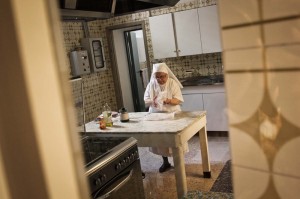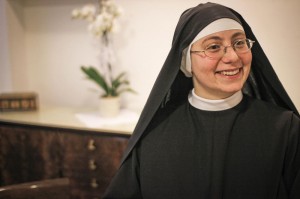Nuns from two different religious orders find common ground in a city with ancient ties to the Catholic Church.
URBINO, Italy — An irrevocable vow binds the women who choose this order of marriage, the marriage to God.
Describing her first profession of vows as a nun brings a smile to Sister Antida Tavoni as she recalls her engagement with her heavenly spouse 53 years ago. Her face and glasses are tightly framed by a white habit, with only a small hint of silver and gray hair showing near her widow’s peak.
It’s quiet in Suore della Carita Pensionato Universitario S. Felicita, a dormitory in Urbino that houses female university students and is maintained by Sister Antida and five other nuns from the Sisters of Charity congregation.

Sister Angelina unwraps raw meat as she prepares dinner for the house. After retiring as an expert sewer the petite nun can be found in the kitchen of Sisters of Charity a few times a day preparing meals for the house.
Within the walled city of Urbino are the walled communities of Catholic religion. To outsiders, the cloistered life can seem incomprehensible and unconnected to their world. But visiting with nuns in two of these communities one finds that they are actually connected to the world in their own ways, and each order plays a distinct role. In the 21st century, the nuns see their traditional life as still relevant.
Sister Antida sits at a crochet-covered table; her hands lying still on her lap. Her style of dress is a means of representing her conjugal bond with God, which began the day she took her final vows as a nun.
“The moment in which I understood that I had the vocation to become a nun, it was like an engagement,” she remembers. “As a young woman falls in love with a young man, I fell in love with the Lord.”
This dormitory is run by just one of several chapters of the Sisters of Charity that serve society by being in charge of such institutions as schools, orphanages and hospitals. Sister Antida’s primary role involves the financial affairs of the house and other paperwork.
She says she is not meticulous about the paperwork, but loves interacting with the students.
[pullquote]The thing I love the most is working with the young people. They change over time … their mentality and generation.[/pullquote]
“The thing I love the most is working with the young people. They change over time … their mentality and generation.” She says she can particularly relate to the young women who are in love, “because I went through the same thing with Jesus.”
Sister Antida gushes about the relationships she has maintained with the women who have since graduated and moved out.
“A girl who once lived here said she wished I had Skype, and I say, ‘I have Skype,’” she laughs. “So we talked and keep in touch often.”
Preserving good relationships beween the nuns and students is important to the nuns of the dormitory, but also important to the students. Elide Critelli, 24, is studying economy in Urbino and has lived with the Sisters of Charity for five years. Growing up Catholic, Critelli decided to live in this dorm facility because of the advantages it provides as well as the good relationships she has built with the Sisters of the Charity. Although some students in the past who have lived in this dormitory have gone on to take their final vows as nuns, Critelli doesn’t see this in her future. “I hope to get a job in this area, and I plan to stay in touch with the nuns here,” she says.
Meanwhile, there is a world just a short distance away where cloistered nuns pray as their special effort to assist the outside world. Il Monastero Agostiniane di S. Caterina d’Alessandria, located in via Staffi near the Cathedral of Urbino, houses 12 nuns who have taken their vows and observe a quiet, sequestered life.

Sister Dora joined the cloistered nun community of Il Monastero Agostiniane di S. Caterina d’Alessandria in 2001 soon after she found her love with the Lord.
The life of this cloistered community is not completely closed off from the outside world. Two thin, tall doors offer ingress to the church adjacent to the convent. Inside, the public is invited to pray with the 12 nuns and a priest daily.
The nuns of the Augustinian convent are restrained confined to the premises of the cloister, and rarely invite an outsider within their cells. The convent does, however, have a separate room where the nuns may converse with visitors, such as family.
Sister Dora has been a member of the cloistered community since 2001 and, like Sister Antida, a smiles when revisiting her history and life with the Lord. She sits behind a wall nearly three feet high. Although visitors from outside are not allowed to encroach on the area past this barricade, Sister Dora casually rests her elbows on top and lets her arms dangle over the edge.
When deciding to join the Augustinian convent, Sister Dora knew she would have to abandon her old life and take on new responsibilities as a member of the community.
“Joining the convent did generate some sorrow,” she says, “ I cried, they cried.” Even though she felt a huge detachment from her family, she knows that this is God’s call to her and she is meant to live the cloistered life.
The two monasteries offer an almost indistinct contrast to any outsider not involved in the religious community, but the juxtaposition radiates inside the orders. Unlike the Sisters of the Charity, the nuns in the cloistered monastery are mainly concerned with prayer. They spend most of their day in prayer and follow a strict schedule. The ringing of a bell indicates a different chapter of the day and it is important for the nuns to be punctual, Sister Dora says. The nuns are directed to study for an hour by themselves then for another hour with other members. The most important aspect of life in a cloistered community, Sister Dora stresses, is “spending time with each other.”
[pullquote]We do just what any friends do.[/pullquote]
“We do just what any friends do,” she says. Watching television together, playing sports and even delving into the Internet allows the women to spend their allotted free time together and bond.
The Augustinian convent reaches out to the community in more than just prayer. The nuns maintain a hostel for students who plan to stay in Urbino temporarily during exam time. The nuns offer their hostel to the parents who come to visit daughters who reside with the Sisters of Charity.
It’s also a way for the Augustinian convent to raise money. “They make us an offer to stay at the hostel, and then we take them in,” Sister Dora says. Though the Sisters of Charity do not follow a rigorous schedule like the cloistered monastery, two communities of nuns interact regularly. “We go pray with them and we work together,” Sister Antida says.
Sisters of Charity is a congregation that is known for reaching out to the community. Sister Antida explains the difference between cloistered communities like the St. Augustine and the Sisters of the Charity by citing the story of Mary and Martha in the Gospel of Luke. Martha represents life in the world where she is more active, whereas the other will stay with Jesus and represents the contemplative life. Mary represents the cloistered nun community. “We represent the activists; we are in the world,” Sister Antida says. “We pray, but we are also called to be in the world.”
Though the two communities participate in the outside world in different ways, both Sister Dora and Sister Antida allude to what Jesus says in Matthew 19:29, “And everyone who has left houses or brothers or sisters or father or mother or wife or children or fields for my sake will receive a hundred times as much and will inherit eternal life.”
Though the two communities of nuns practice their faith in different ways, both follow this specific Gospel and find it a prime reason for giving their lives to the Lord.
Sister Antida says she is finally is beginning to understand things that were not clear before. “I am becoming aware that what Jesus says in the Gospel is true and that I am experiencing it in my life,” she says.
Sister Dora, for her part, believes she is not missing out by remaining inside the walls of her convent. “The time may change, the economy may change but the human being is always the same…his happiness, his suffering.”
Video
Produced by Kaitlin McKinney and Emily Harmon
Multimedia Slideshow